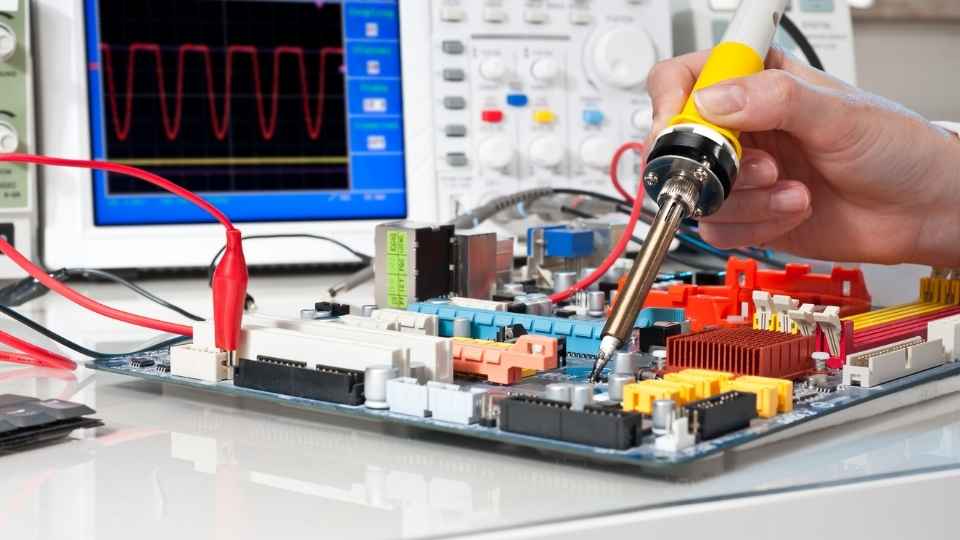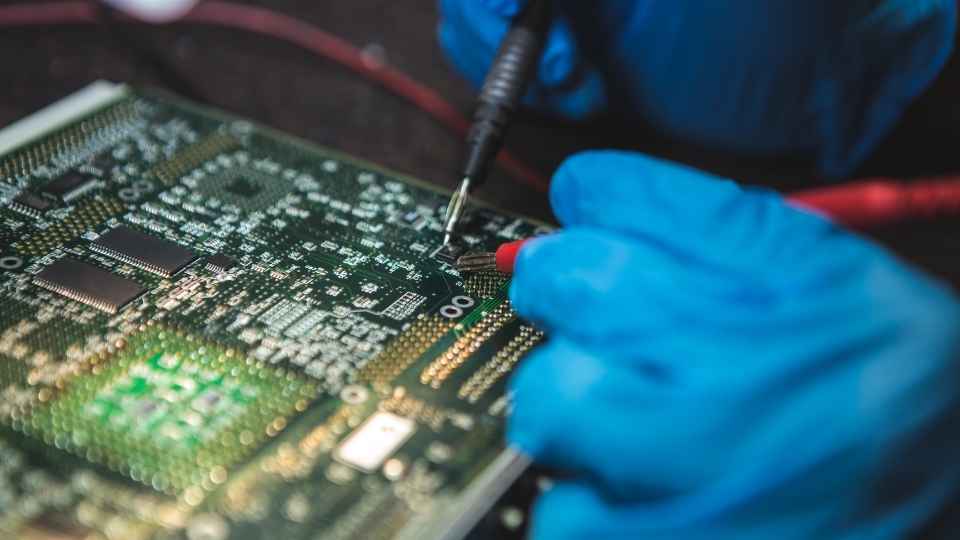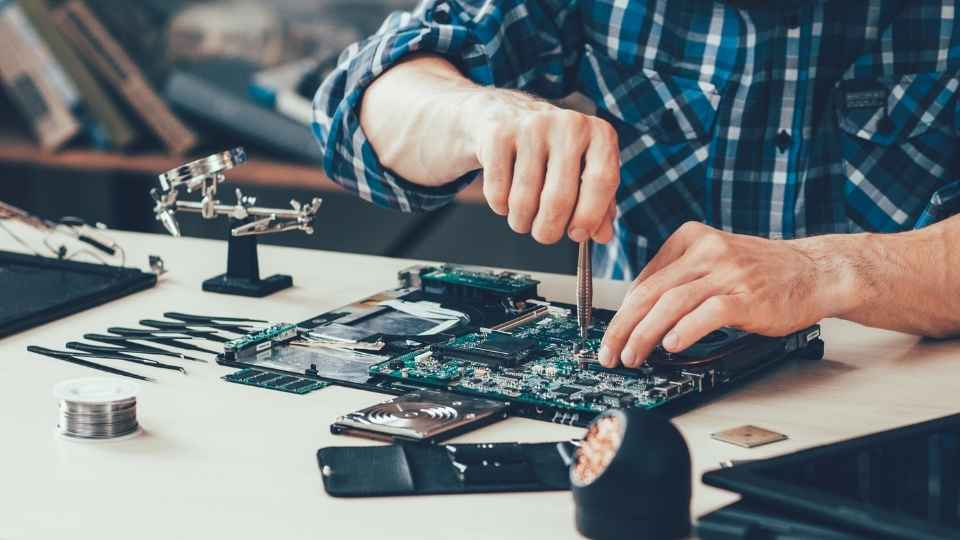
In the world of technology, microcontrollers (MCUs) serve as the heart and soul of countless devices that surround us. From smartphones to smart home appliances, these small yet powerful chips bring life to our daily routines.
But have you ever wondered how they come alive? In this article, we delve into the intricate realm of microcontroller programming, exploring the significance of the C language, assembly programming techniques, essential firmware concepts, IDE selection tips, and effective debugging strategies.
Get ready to unlock new dimensions in MCU programming and breathe life into these fascinating devices.
Key Takeaways
- The C language is significant in microcontroller programming.
- Memory management techniques include static and dynamic memory allocation.
- Interrupt handling basics involve interrupt requests and priority levels.
- Data storage strategies include using internal EEPROM or flash memory, as well as external non-volatile memory chips.
The Significance of the C Language
The C language holds significant importance in microcontroller programming due to its ability to directly access hardware, optimize memory usage, and provide a low-level control over the system.
When programming microcontrollers, it is essential to have direct access to hardware resources such as registers, input/output pins, timers, and interrupts. The C language allows programmers to manipulate these resources efficiently and precisely, enabling them to create highly optimized code that can run on resource-constrained devices.
Furthermore, microcontrollers often have limited memory capacity. The C language's efficient memory management capabilities allow programmers to utilize the available memory effectively. It provides features like pointers and manual memory allocation that enable programmers to control how data is stored and accessed in the device's limited memory space.
Additionally, the C language offers low-level control over the system by providing direct manipulation of bits and bytes. This level of control allows programmers to implement complex algorithms or custom protocols with precise timing requirements.

Overall, the use of the C language in microcontroller programming empowers developers with freedom and flexibility to maximize performance while working within resource constraints.
Exploring Assembly Programming
Exploring assembly language provides an in-depth understanding of the low-level operations and execution flow within microcontrollers. Assembly language is a programming language that directly corresponds to the machine code instructions of a specific processor architecture. It offers complete control over hardware resources and allows programmers to optimize performance by accessing registers, memory, and I/O ports directly. By delving into assembly programming, developers gain a profound insight into how microcontrollers function at the fundamental level.
Assembly programming enables programmers to write highly efficient and customized code for microcontrollers. It allows for fine-grained control over program execution, making it ideal for applications that require real-time responsiveness or have strict resource constraints. Additionally, understanding assembly language facilitates debugging and troubleshooting in situations where higher-level languages fall short.
Although assembly programming requires meticulous attention to detail and can be time-consuming compared to high-level languages, it empowers programmers with unparalleled freedom and has its place in low-level system development. Mastery of assembly language opens up new possibilities for microcontroller programming, providing developers with the tools they need to breathe life into their projects with precision and efficiency.
Essential Firmware Concepts
Before delving into the specific techniques and strategies involved in firmware development, it is essential to have a solid understanding of the core concepts that underpin this field.
These concepts include:
Memory management techniques, which involve efficiently allocating and managing memory resources within a system.

Interrupt handling basics, which deal with how a microcontroller responds to external events or signals.
Data storage strategies, which determine how data is stored and accessed within the firmware.
A thorough grasp of these fundamental concepts will provide a strong foundation for successfully designing and implementing firmware solutions.
Memory Management Techniques
Effective memory management techniques are crucial for optimizing the performance and efficiency of microcontroller programs. With limited resources, it is essential to carefully allocate and deallocate memory to prevent memory leaks and fragmentation.
One approach is to use static memory allocation, where the required amount of memory is determined at compile-time. This ensures efficient usage of memory but may limit flexibility.
Another technique is dynamic memory allocation, where memory is allocated and deallocated during runtime using functions like malloc() and free(). However, this method requires careful handling to avoid issues like fragmentation or running out of available heap space.
Balancing these techniques based on the specific requirements of a program can significantly enhance its performance and reliability.

Transitioning into the subsequent section about 'interrupt handling basics,' proper management of interrupts is equally important in microcontroller programming.
Interrupt Handling Basics
Interrupt handling is a critical aspect of managing the flow of execution in microcontroller programs. When an interrupt occurs, the program temporarily stops its current operation to handle the incoming event.
Here are five key aspects of interrupt handling that are essential for effective program execution:
Interrupt request (IRQ): An external or internal event triggers an IRQ, causing the processor to pause its current task and jump to the corresponding interrupt service routine (ISR).
Priority levels: Interrupts can have different priority levels, allowing higher priority interrupts to preempt lower priority ones.
Interrupt vectors: Each type of interrupt has a unique vector address that points to its associated ISR.
Context saving: Before jumping to the ISR, the processor saves the context (registers, flags) of the interrupted task so it can resume later.

Interrupt enable/disable: Interrupts can be globally enabled or disabled using special registers, preventing certain interrupts from occurring during critical sections.
These mechanisms ensure efficient management of multiple events and allow programmers freedom in designing responsive microcontroller systems.
Data Storage Strategies
Data storage is a crucial aspect of designing efficient and reliable systems, ensuring that information is securely stored and easily accessible.
When it comes to microcontroller programming, choosing the right data storage strategy is essential for optimizing performance and memory usage. There are several options available, such as using internal EEPROM or flash memory, external non-volatile memory chips, or even utilizing cloud-based storage solutions. Each option has its advantages and considerations in terms of cost, speed, durability, and capacity.
It is important to analyze the specific requirements of your project and choose the most suitable approach for data storage. By carefully considering these factors, you can ensure that your microcontroller system efficiently handles data storage while providing the freedom to expand functionality without compromising reliability.
Now that we have discussed data storage strategies let's move on to the next section: choosing the right IDE for microcontroller programming.
Choosing the Right IDE for Microcontroller Programming
When selecting an Integrated Development Environment (IDE) for microcontroller programming, it is important to consider factors such as:

- Ease of use
- Compatibility with your chosen microcontroller platform
- Available debugging features
To help you visualize the ideal IDE, here are five key elements to consider:
- Intuitive Interface: A user-friendly interface allows for efficient coding and quick navigation.
- Platform Compatibility: Ensure that the IDE supports your microcontroller platform to avoid compatibility issues.
- Code Editor Features: Look for features like syntax highlighting, code completion, and version control integration to enhance productivity.
- Debugging Tools: Effective debugging tools like real-time memory visualization and breakpoints expedite the troubleshooting process.
- Community Support: Opt for an IDE with a strong community presence where developers can share knowledge and offer assistance.
With these considerations in mind, let's explore effective debugging techniques for microcontrollers.
Effective Debugging Techniques for Mcus
To efficiently troubleshoot issues and ensure optimal performance, it is essential to employ effective debugging techniques when working with microcontrollers.
Debugging is the process of identifying and resolving errors or bugs in a program. One common approach to debugging microcontroller programs is using breakpoints. Breakpoints allow programmers to pause the execution of code at specific points, allowing for inspection of variables and memory values.
Another technique is stepping through the code line by line, which can help identify logical errors or unexpected behavior.
Additionally, logging and printing debug information to a serial console can be useful in understanding the flow of execution and identifying potential issues.
Breathing Life Into Mcus: Best Practices and Tips
Breathing life into Mcus is a crucial aspect of microcontroller programming, as it ensures optimal performance and efficiency.

To achieve this, developers must adhere to best practices and employ various tips that enhance memory optimization, efficient power management, and real-time performance considerations.
Memory Optimization Techniques
Implementing memory optimization techniques is crucial for efficient microcontroller programming and maximizing the available resources. To achieve this, consider the following:
Code size reduction: Minimize unnecessary code by removing unused functions, variables, and libraries.
Data structure optimization: Use appropriate data structures like arrays instead of linked lists to reduce memory overhead.
Compiler optimizations: Enable compiler optimizations to generate efficient machine code.
Memory allocation strategies: Utilize dynamic memory allocation techniques such as pooling or stack-based allocation to minimize fragmentation.
Use of flash memory sparingly: Store non-volatile data in external storage devices instead of using precious on-chip flash.

By implementing these techniques, developers can ensure that their microcontrollers run smoothly and efficiently while making the most out of limited resources.
With a well-optimized memory management strategy in place, it becomes easier to transition into discussing efficient power management.
Efficient Power Management
Efficient power management is a crucial aspect of microcontroller programming that allows for longer battery life and reduces energy consumption. By implementing intelligent strategies, developers can optimize the usage of power-hungry components such as sensors, wireless modules, and display interfaces.
One effective technique is to utilize low-power modes, where unnecessary functionalities are disabled or put into sleep mode when not in use. Additionally, utilizing interrupts instead of continuously polling for events can significantly reduce power consumption.
Furthermore, optimizing algorithms and code can help minimize execution time and decrease overall power consumption. Finally, using hardware features like voltage regulators and power gating techniques enables fine-grained control over power distribution within the system.
Employing these efficient power management techniques empowers developers to create energy-efficient solutions that meet the demands of a freedom-seeking audience while maximizing battery life.
To ensure optimal operation, developers must carefully balance power consumption with real-time performance considerations when designing microcontroller-based systems. Real-time performance is crucial in many applications, where timely and accurate responses are required. Here are five key factors to consider:

- Clock frequency: Choosing the right clock frequency enables faster execution of instructions, improving real-time response.
- Interrupt handling: Efficient interrupt handling ensures that critical tasks are executed promptly without delaying other processes.
- Memory management: Proper allocation and utilization of memory resources minimize delays in accessing data and code.
- Task scheduling: Implementing an efficient task scheduler allows for prioritization and execution of time-sensitive tasks.
- I/O latency: Minimizing input/output latency improves system responsiveness.
Frequently Asked Questions
What Are the Advantages of Using a Microcontroller for Programming?
Using a microcontroller for programming offers several advantages. It allows for precise control over hardware components, is cost-effective, and enables efficient power management. Additionally, microcontrollers provide real-time processing capabilities and are highly versatile in various applications.
Are There Any Limitations to Using the C Language for Microcontroller Programming?
There are limitations to using the C language for microcontroller programming. Some of these include limited memory resources, lack of real-time capabilities, and difficulties in handling low-level hardware operations.
How Can I Choose the Right Microcontroller for My Project?
Choosing the right microcontroller for a project requires careful consideration of factors such as processing power, memory capacity, input/output capabilities, and cost. Additionally, it is important to assess compatibility with programming languages and development tools to ensure efficient implementation.
What Are Some Common Challenges Faced During Microcontroller Programming and How Can They Be Overcome?
Common challenges in microcontroller programming include memory constraints, real-time operating system implementation, and debugging issues. These can be overcome by optimizing code size, using efficient algorithms, and utilizing debugging tools for efficient troubleshooting and error detection.
Can You Provide Some Examples of Real-Life Applications Where Microcontroller Programming Is Used?
Microcontroller programming is widely used in various real-life applications, such as home automation systems, industrial control systems, medical devices, and automotive electronics. It enables the control and operation of these devices through efficient code execution on microcontrollers.
 Basic Electronics ConceptsEssential ToolsCircuit Design BasicsMicrocontrollersDIY Electronics ProjectsRoboticsPrivacy PolicyTerms And Conditions
Basic Electronics ConceptsEssential ToolsCircuit Design BasicsMicrocontrollersDIY Electronics ProjectsRoboticsPrivacy PolicyTerms And Conditions
